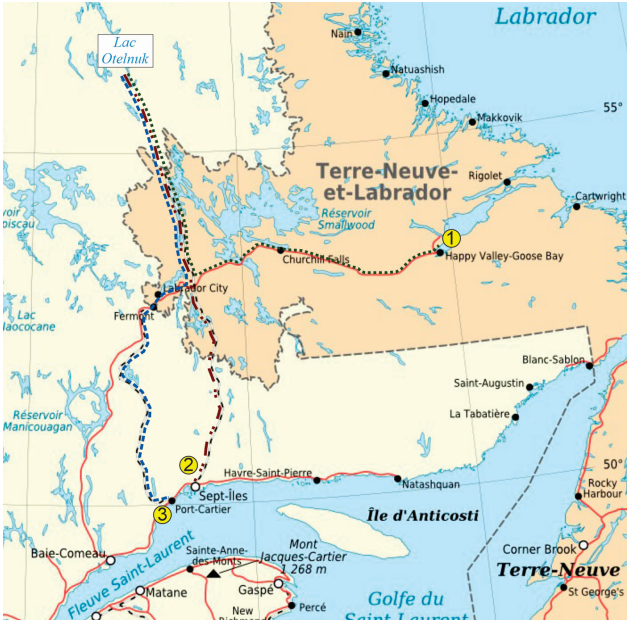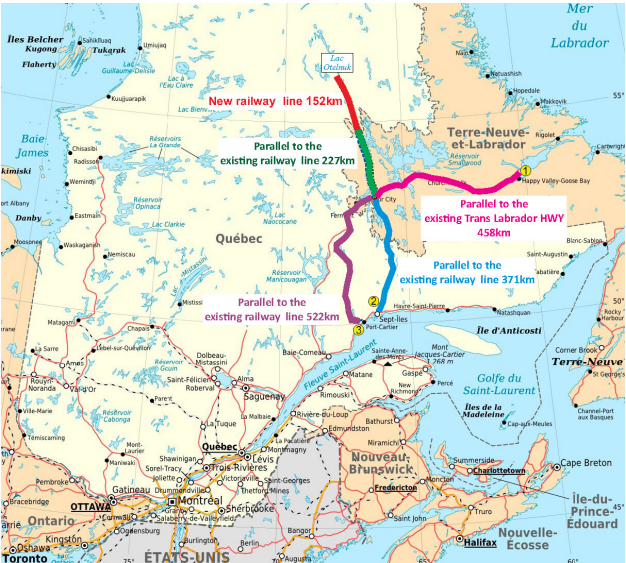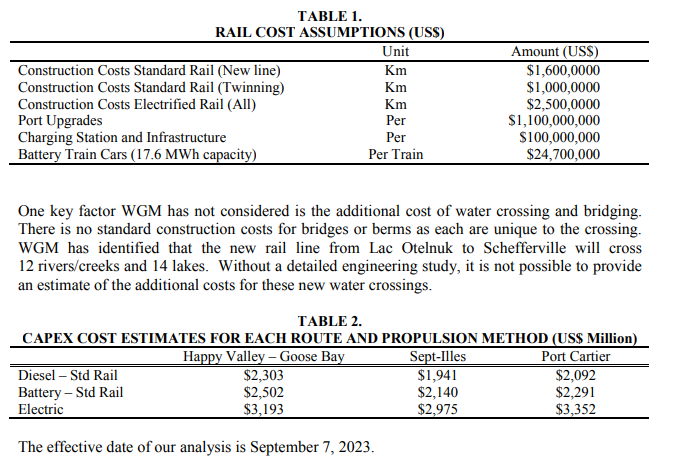(TheNewswire)
 |
|
October 25th, 2023 – TheNewswire - Rockport, Ontario – (TSXV:MQM); (OTC:MQMIF); FSE:E7Q.F) (“MQM” or “Company”) is pleased to provide an overview of a report for conceptual rail corridors which will support the infrastructure needs of the Lac Otelnuk Iron Ore Project (the “Project” or “Lac Otelnuk”). The Lac Otelnuk Iron Ore Project is located approximately 165 km by air northwest of the village of Schefferville, and 1200 km northeast of Montreal by air. Given the size and scope of the Lac Otelnuk Project, management of MQM are working with a Toronto-based engineering Company familiar with the project to create a go-forward development plan. The Quebec government has recently transferred the claims into MQM’s name and management is accumulating a vast amount of technical data as approximately $150 million has been expended on the project to date. Going forward, one of our primary objectives will be to work with Wasayao Strategy Group, a Quebec-based First Nations consulting firm, that will work with MQM to secure a Memorandum of Understanding (MOU) with local First Nations and other stakeholders. Management is continuing to develop its in-house Iron ore database to enable the Company to secure an Option/Joint Venture partner from the Iron ore industry.
Proposed Rail Corridor Routing Methodology
Watts Griffis & McOuat’s (WGM) study, commissioned by MQM, has been based on topography and physical access only. There exists extensive engineering, environmental, community consultation, and permitting required to plan and build a rail line which is beyond the scope of the study. WGM’s work has been designed to be used primarily to promote Lac Otelnuk, consult with stakeholders in the rail lines, and seek to get rail access to support Lac Otelnuk. If successful, rail engineering and logistics experts will need to undertake the necessary planning and studies.
WGM has attempted to follow the local topography to minimize grade and crossing of water courses. Any steep terrain would require tunnelling and water courses require bridges and/or berms. Once the proposed rail line can intersect existing railheads and/or highways, the proposed rail routes will either twin existing rail lines or be routed beside highways. This process results in the minimization of new track bed construction, reduced environmental study, and maximizes potential use of existing infrastructure. WGM believes this conceptual approach to be pragmatic and would closely approximate any eventual rail line.
Proposed Rail Corridor Routing
Based on MQM’s requirements to get to tide water, with a port which operates for the majority of the year in order to sell its iron ore to international markets, WGM has developed the following three routes: 1) Lac Otelnuk to Happy Valley Goose Bay; 2) Lac Otelnuk to Sept-Illes; and, 3) Lac Otelnuk to Port Cartier. These routes are noted below in Map 1.

Map 1. Proposed Rail Corridors Connecting Lac Otelnuk to Ports
The first 152 km of track from Lac Otelnuk will be new rail line leading to the existing railhead at Schefferville, PQ which leads down to Rose Bay junction, Labrador City, and Highway 500. Existing rail links exist to Sept-Illes and Port Cartier. The route to Happy Valley Goose Bay would require a new rail line parallel to Highway 500 and a total length of 837 km (227 km Twinned track and 610 km new track). The route to Sept-Illes would have a total length of 750 km (598 twinned track and 152 km of new track). The route to Port Cartier would have a total length of 901 km (749 of twinned track and 152 of new track). The new and twining track routes are noted in Map 2 below.

Map 2. New and Twined Rail Lines to Three Possible Ports
Proposed Rail Corridor Technical Analysis
The next consideration for evaluating the optimal option for Lac Otelnuk is the type of rail being considered: standard or electrified. Standard rail is the default option for North America due to cost. However, given the increase in carbon taxes, market demand for carbon intensity reduction in projects, and the support by governments, communities, and First Nations for clean projects, it may prove to be more economic in the longer term to consider an electrified line.
Electrified lines are the norm in much of Europe and Asia due to their efficiency and reduced pollution. The downside is the upfront capital cost for electrified lines are more then double the cost of standard rail lines. Further, maintenance, safety and monitoring requirements are more substantive resulting in higher operating costs.
There exists a third option: laying standard rail lines but electrifying the freight trains using battery technology. A recent study by Zenith, Federico, et al in 2020 looked at the power requirements for freight trains via a case study in Norway versus the United States. They conclude that for low traffic lines electrification is more favourable and, battery power can be reasonably considered. Unfortunately, the cost of traditional lithium battery technology is growing exponentially due to the demands for the electrification of vehicles and limited supplies. A superior technology for industrial use is Vanadium batteries. These large size and high capacity batteries use the valence of Vanadium to store energy without degradation experienced by other technologies. This technology is being considered for use for ships and rail lines (see “Revisiting Vanadium Flow Batteries for Ship Propulsion” -1 by Harry Valentine). While not having been tried, the article notes it is viable.
Another consideration of Vanadium battery technologies is the abundance of inexpensive, green hydro energy from either Hydro Quebec or from Churchill or Muskrat Falls in Newfoundland. Charging stations along the route proximal to these power sources appears desirable and efficient.
Port Availability
WGM has researched the capabilities of the existing three end-of-rail port facilities and notes that both Port Cartier and Sept-Illes are at full capacity and would require extensive expansions to handle the cargo from Lac Otelnuk. Happy Valley Goose Bay is under-utilized and may offer a more economical option. However, it only offers 9 months of operation per year rather than full year operations by the more southerly ports.
Proposed Rail Corridor Economic Analysis
WGM has attempted to provide a very high-level analysis of the capital costs associated with each rail route and its options for track type: electric verse standard rail based on the most current construction costs estimates. WGM have used the following assumptions:

Economic Benefits
Using the latest available economic multipliers and job creation factors from Statistics Canada, WGM has estimated that the building of the new access rail lines to tide water will unlock US$28.3 Billion in primary economic activity and, after fully factoring in multiplier effects, US$42.1 Billion in additional economic activity for the Provinces of Quebec and Newfoundland & Labrador. WGM estimates the creation of 119,932 permanent full-time jobs related to the direct and indirect economic activity generated by the building of a new rail corridor, new mines along the route and the Lac Otelnuk project.
Additional Considerations
WGM, during their analysis, wanted to raise number of additional factors for consideration:
• The Government of Newfoundland and Labrador are actively seeking customers for the Churchill Falls and Muskrat Falls hydro projects. Additionally, they are seeking to revitalize the Happy Valley Goose Bay port facilities. Both provide powerful motivators to support the proposed route through Labrador.
• Transportation links to far Northern communities in Quebec and Labrador are desirable for all governments and First Nations.
• Use of an electrified train (via electrified lines or batteries) will be a first in North America for freight. This provides favourable government, First Nations, and community impressions of the project due to both its novelty, economic benefits, and green credentials.
• Use of an electrified train will likely allow MQM to draw on support from various government funds for both infrastructure and green projects which could reduce CAPEX costs further.
• Electrified trains will improve the ESG scores for MQM for the project which will likely make the project more desirable for generalist investors.
Recommendations
WGM does not have any specific bias toward the three proposed routes; all are viable. WGM recommends MQM seriously consider further engineering study of using battery powered trains on standard track as they believe this offers the optimal strategy for attracting the necessary investment, government, First Nations and community support to ensure the project proceeds. WGM trusts their proposed rail corridors and economic projections for the Lac Otelnuk Iron Ore project are enlightening and will aid the company in its plans.
About MetalQuest Mining
MetalQuest Mining (MQM) owns a 100% of Otelnuk and is further looking to develop one of the largest Iron ore projects in North America. The Lac Otelnuk Iron Ore Project is located in Quebec’s Labrador Trough and is approximately 165 km by air northwest of the village of Schefferville, and 1200 km northeast of Montreal by air. Given the size and scope of the Lac Otelnuk Project, management of MQM are working with a Toronto-based engineering Company familiar with the project to create a go-forward development plan. The Quebec government has recently transferred the claims into MQM’s name and management is accumulating a vast amount of technical data as approximately $150 million has been expended on the project to date. Going forward, one of our primary objectives will be to work with Wasayao Strategy Group, a Quebec-based First Nations consulting firm, that will work with MQM to secure a Memorandum of Understanding (MOU) with local First Nations and other stakeholders. Management is continuing to develop its in-house Iron ore database to enable the Company to secure an Option/Joint Venture partner from the Iron ore industry. The Company is diversified with a ~28.2% stake in Murray Brook PEA Stage Zinc-Polymetallic Deposit, situated in the famous Bathurst Mining District, New Brunswick, Eastern Canada and has entered into Binding Letter of Intent dated September 11th, 2023 to sell this interest to Canadian Copper Inc (CCI) subject to cash payments, issuance of a Royalty, issuance of units in CCI and a pre-production cash payment of $1 million.
Investors are invited to visit the MetalQuest Mining website at www.metalquestmining.com where they can review the company and its corporate activities. Any questions or comments can be directed to Harry Barr at Hbarr@mqmining.com or Farid Mammadov at faridm@mqmining.com or call 613 659 2773.
Opt-in List
If you have not done so already, we encourage you to sign up on our website (www.mqmining.com) to receive our updated news. On behalf of the Board of Directors
“Harry Barr”
Harry G. Barr
Chairman and CEO
Neither the TSX Venture Exchange nor its Regulation Services Provider (as that term is defined in the policies of the TSX Venture Exchange) accepts responsibility for the adequacy or accuracy of this release. Cautionary Note Regarding Forward Looking Statements: This release contains forward-looking statements that involve risks and uncertainties. These statements may differ materially from actual future events or results and are based on current expectations or beliefs. For this purpose, statements of historical fact may be deemed to be forward-looking statements. In addition, forward-looking statements include statements in which the Company uses words such as “continue”, “efforts”, “expect”, “believe”, “anticipate”, “confident”, “intend”, “strategy”, “plan”, “will”, “estimate”, “project”, “goal”, “target”, “prospects”, “optimistic” or similar expressions. These statements by their nature involve risks and uncertainties, and actual results may differ materially depending on a variety of important factors, including, among others, the Company’s ability and continuation of efforts to timely and completely make available adequate current public information, additional or different regulatory and legal requirements and restrictions that may be imposed, and other factors as may be discussed in the documents filed by the Company on SEDAR (www.sedar.com), including the most recent reports that identify important risk factors that could cause actual results to differ from those contained in the forward-looking statements. The Company does not undertake any obligation to review or confirm analysts’ expectations or estimates or to release publicly any revisions to any forward-looking statements to reflect events or circumstances after the date hereof or to reflect the occurrence of unanticipated events. Investors should not place undue reliance on forward-looking statements.
Copyright (c) 2023 TheNewswire - All rights reserved.